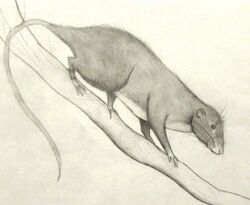Biology:Dactylomys
| Dactylomys | |
|---|---|
| Scientific classification | |
| Domain: | Eukaryota |
| Kingdom: | Animalia |
| Phylum: | Chordata |
| Class: | Mammalia |
| Order: | Rodentia |
| Family: | Echimyidae |
| Subfamily: | Echimyinae |
| Tribe: | Echimyini |
| Genus: | Dactylomys Saint-Hilaire, 1838 |
| Type species | |
| Dactylomys typus | |
| Species | |
|
Dactylomys boliviensis | |
| Synonyms | |
|
Lachnomys Thomas, 1916 | |
Dactylomys is the genus of South American bamboo rats[1] They are arboreal members of the family Echimyidae.
Systematics
The genus name Dactylomys derives from the two Ancient Greek words δάκτυλος (dáktulos), meaning "finger", and μῦς (mûs), meaning "mouse, rat",[2][3] and refers to the middle two digits especially elongated relative to lateral ones as observed in these rodents.[4]
The genus contains three species:
- Dactylomys boliviensis (Bolivian bamboo rat)
- Dactylomys dactylinus (Amazon bamboo rat)
- Dactylomys peruanus (Montane bamboo rat)
Phylogeny
Dactylomys is a member of the Echimyini clade of arboreal Echimyidae rodents. The closest relative of Dactylomys is Olallamys, and then Kannabateomys. These South American bamboo rats share unique features and are grouped under the informal clade name of "Dactylomyines".[5] The dactylomyines are the sister genera to Diplomys and Santamartamys. All these taxa are closely related to the genera Echimys, Phyllomys, Makalata, Pattonomys, and Toromys. In turn, these genera share phylogenetic affinities with the clade containing Lonchothrix and Mesomys, and with Isothrix.[6]
| Genus-level cladogram of the Echimyini. |
References
- ↑ Woods, C.A.; Kilpatrick, C.W. (2005). "Genus Dactylomys". in Wilson, D.E.; Reeder, D.M. Mammal Species of the World: A Taxonomic and Geographic Reference (3rd ed.). Johns Hopkins University Press. p. 1576. ISBN 978-0-8018-8221-0. OCLC 62265494. http://www.departments.bucknell.edu/biology/resources/msw3/browse.asp?id=13400408.
- ↑ Bailly, Anatole (1981-01-01). Abrégé du dictionnaire grec français. Paris: Hachette. ISBN 978-2010035289. OCLC 461974285.
- ↑ Bailly, Anatole. "Greek-french dictionary online". http://www.tabularium.be/bailly/.
- ↑ Patton, James L.; Pardiñas, Ulyses F. J.; D’Elía, Guillermo (2015-03-09) (in en). Mammals of South America, Volume 2: Rodents. University of Chicago Press. p. 880. ISBN 9780226169576. https://books.google.com/books?id=4aHLBgAAQBAJ&pg=PA880.
- ↑ Fabre, Pierre-Henri; Patton, James L.; Leite, Yuri L. R. (2016). "Family Echimyidae (hutias, South American spiny-rats and coypu)". Handbook of the Mammals of the World. Vol 6. Lagomorphs and Rodents I. Barcelona: Lynx Edicions. pp. 552–641. ISBN 978-84-941892-3-4.
- ↑ Fabre, Pierre-Henri; Upham, Nathan S.; Emmons, Louise H.; Justy, Fabienne; Leite, Yuri L. R.; Loss, Ana Carolina; Orlando, Ludovic; Tilak, Marie-Ka et al. (2017-03-01). "Mitogenomic Phylogeny, Diversification, and Biogeography of South American Spiny Rats". Molecular Biology and Evolution 34 (3): 613–633. doi:10.1093/molbev/msw261. ISSN 0737-4038. PMID 28025278.
Wikidata ☰ Q901102 entry
 |


